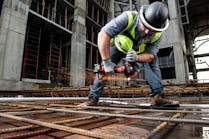Construction equipment fleet managers and their drivers face unknown and often unexpected challenges on the road. Traffic jams, inclement weather, and aggressive or distracted driving are just a few that can create a potentially unsafe situation.
Aries is head of Global Product Success for Verizon Connect.
About eight people in the U.S. are killed daily in crashes involving a distracted driver, according to the Centers for Disease Control and Prevention. Human safety is always the top concern, but these situations can also result in reputational damage to the business, large insurance liabilities, and costly repairs—especially when there are no other witnesses and fleet drivers have no verifiable proof of their actions or intent.
In a survey of Verizon Connect fleet customers, 65 percent said that they believe that fleet vehicles are the first to be considered responsible in a crash when a passenger vehicle is involved, even when that’s not the case. The American Transportation Research Institute’s Critical Issues in the Trucking Industry Report showed that lawsuit abuse reform had become one of the fifth highest industry concerns in 2021.
Modern dashcam solutions are typically part of a larger comprehensive fleet-management solution. When combined, they provide a clear, nearly real-time view of daily operations to help businesses focus on driver safety, reduce costs, increase productivity, and stay ahead of vehicle maintenance.
How dashcams work
For dashcams, expected features include high-definition video capture with the ability to see the driver’s field of vision, the ability to withstand heat and vibration, and cloud storage in the event the camera is damaged. Once the engine turns on, the dashcam system begins recording and continues to do so until the engine is turned off.
A harsh driving event such as a sudden acceleration or hard braking triggers special software that marks the video and saves it in the cloud so the footage can be reviewed on a mobile device or desktop for later use. When combined with precise location information, fleet managers also receive an alert to quickly view the identity of the driver, their speed, and their location in near-real time on a live map.
When construction fleet managers and corporate management need to determine the facts if a crash occurs, dashcam footage is a way to protect the organization against false claims. The video can also be used as an important training tool to individualize driver training and instill better and safe driving practices, helping to reduce potential risks.
Fleet management technology provides valuable details in the event of theft as well, because it can deliver proof of an incident with near real-time tracking capabilities to display the location of a missing vehicle on a map.
Improving safety with dashcams
These features mean fleet managers are always in the know. Although strategies to combat safety and liability issues include advocating for elimination of damages and better identifying the cause of accidents, the use of digital fleet management solutions with dashcams puts safety benefits in clear focus.
Adoption of dashcam solutions remains relatively low. Right now, most fleet managers (64 percent) that use Verizon Connect fleet management technology have not yet adopted dashcams, even though it suggests clear benefits for their use.
Companies are already reaping the benefits of dashcams and digital fleet solutions. Fiber optic installer Wolf Line Construction deployed an advanced fleet-management solution and the company increased efficiency by up to 25 percent across its fleet, decreased time spent in the field as well as fuel and mileage needed to locate crews, and prioritized driver safety with the use of dashcams.
With dashcams helping to promote driver safety and protect businesses from crashes and theft, video looks set to be a centerpiece of the future of fleet management solutions.






